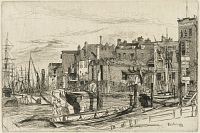KEYWORD
barge, police, rowing boat, river, sailing ship, shipping, warehouse, wharves, worker.
TITLE
There are two main variations in title, as follows:
'
THAMES POLICE.' and '
WAPPING WHARF' (1859, Whistler).
1
'
Thames Police' (1862?, Whistler).
2
'
Thames Police' (1863, Whistler).'
3
'
Wapping Wharf' (1871, Ellis & Green).
4
'
Thames Police' (1874,
Ralph Thomas, Jr (1840-1876)).
5
'
Thames Police. Wapping wharf' (1881, Union League Club).
6
'
Thames Police' (1886,
Frederick Wedmore (1844-1921)).
7
'
Wapping Wharf' (1909,
Howard Mansfield (1849-1938)).
8
'
The Thames Police' (1905, ISSPG).
9
'
Thames Police' is by far the most conspicuous sign in the etching, and the Police station is the main focus of the view, which backs up Whistler's original choice of the title, even though the etching was published in 1871 under a different title.
DESCRIPTION
The foreshore of the River Thames at low tide, with a breakwater to right, then a long narrow rowing boat and a barge in the centre. Three men stand by the barge, one wearing a top hat, while another man is at work on the barge. Behind them are a variety of sailing boats, tall masted ships, and barges moored or aground on the shore. Across the background stretch buildings, huts, warehouses and wharves with men at work. At the far right, steps lead up to a narrow four-storey brick building bearing the sign 'THAMES POLICE.' To left of that is a two-storey building with the signs, 'WAPPING WHARF. / YOR[KS]HIRE B[OT]TLE COMPA[NY]'. The scene is lit by strong sunlight from the right, casting shadows back and to left.
SITE
The Thames Police Station was based at No. 255 Wapping High Street. It was a site where Whistler could work with security! According to Wedmore this etching shows:
'The river side at Wapping: ... at the extreme right, with a bow-window in the first and second storey and a flagstaff on the roof, is the station-house of the Thames Police
...
In 1869 the police-station was rebuilt, but again with the prominent bow-windows such as these, from which to survey the River. When I landed at the steps, one morning in the spring of 1885, nearly all the older buildings had disappeared.' 10
Next to the station was the Yorkshire Bottle Company, of which Alfred Alexander was agent. It fronted onto 254 Wapping High Street, and backed onto Phoenix Wharf. 11 It is thus a little surprising that the wall sign says 'WAPPING WHARF.' rather than 'Phoenix Wharf'.
11: Street directory, London Postal Directory, 1859.
In his Thames etchings Whistler focussed on the area of dockside from East London Lime Wharf (241-2 Wapping High Street), past the entrance to the Thames Tunnel, Tunnel Steam Packet Pier, Wapping Dock Stairs, Wheatsheaf Wharf (at No. 233 Wapping High Street), Shap's wharf, Execution Dock Stairs, Phoenix Wharf, the Thames Police Station, Aberdeen Steam Wharf (at No. 257), Baltic Wharf (Tyzack Whitely & Co. at Nos. 266-7), Eagle Wharf (at No. 269), Hermitage Wharf (at No. 343), Watson's Wharf, and Hore's Wharf.
DISCUSSION
Chambers discusses the compositional structure, where the threatening urban environment indicated by the detailed depiction of buildings and boats is modified by the commanding presence of the Police Station:
'The neatly lettered signs which identify the wharves and their owners also operate to fix meaning and function, to control the chaos of unregulated line. This is especially resonant in the etching Thames Police, where the fluid qualities of decay visible in the riverside buildings are restrained by the placing of the firmly lettered sign of the Thames Police on the high brick wall of the station which overlooks and controls the disordered scene.' 12
12: Chambers, Emma, An indolent and blundering art?, Cambridge, 1999, pp. 142-143.
